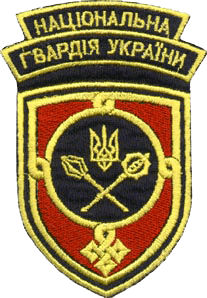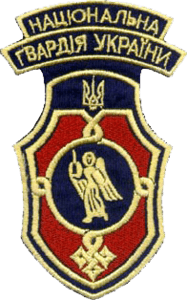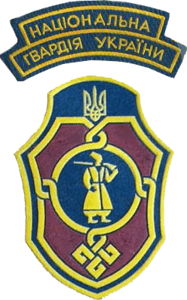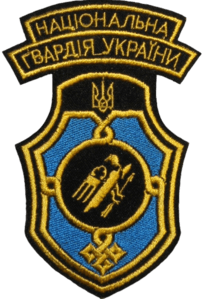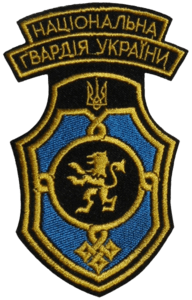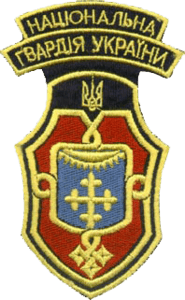National Guard of Ukraine
The National Guard of Ukraine (Ukrainian: Національна гвардія України, Natsionalna hvardiya Ukrayiny) or NGU is the Ukrainian national gendarmerie. It is part of the Ministry of Internal Affairs. It was originally created as an agency under the direct control of the Ukrainian parliament on 4 November 1991, following Ukrainian independence. It was later disbanded and merged into the Internal Troops of Ukraine on 11 January 2000 by then President Leonid Kuchma, as part of a "cost-saving" scheme. Following the early 2014 Ukrainian revolution on 13 March 2014, amidst the Russian intervention, the National Guard was reestablished and the Internal Troops were disbanded.[6]
| National Guard of Ukraine |
|---|
| National Guard of Ukraine Національна гвардія України | |
|---|---|
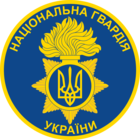 Patch of the National Guard | |
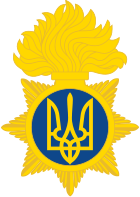 Emblem of the National Guard of Ukraine | |
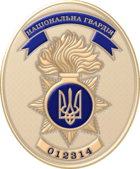 Badge of the National Guard | |
 Ensign | |
| Abbreviation | NGU |
| Motto | Честь, Мужність, Закон Honor, Courage, Law |
| Agency overview | |
| Formed | March 13, 2014[1] |
| Preceding agency | |
| Employees | 46,000 (2016)[2] |
| Jurisdictional structure | |
| Operations jurisdiction | Ukraine |
| Constituting instrument |
|
| General nature | |
| Operational structure | |
| Headquarters | Kiev |
| Agency executive |
|
| Parent agency | Ministry of Internal Affairs |
| Notables | |
| Significant operations |
|
| Anniversary |
|
| Website | |
| ngu | |
During the ongoing war in the Donbass region of Ukraine, the forces of the revived National Guard have fought against pro-Russian separatists and Russian troops disguised as separatists. Due to lack of reserves, earlier in the conflict Azov and Donbass battalions were the largest volunteer units by far with a strength of 1,000 and 900 soldiers respectively plus an extensive civilian support network that reinforced the National Guard.[7][8][9][10]
History
The National Guard was recreated in accordance with the Law of Ukraine "On the National Guard of Ukraine" [Law number 4393] dated 12 March 2014,[11] (the draft legislation being originally introduced to the Ukrainian parliament on 11 March). A previous attempt by then President Yushchenko to bring back the National Guard during civil unrest in 2008 had been blocked in the Rada. It was finally re-established in March 2014 after the beginning of the Crimean crisis.[12]
The NSU was originally created by the Law of Ukraine "On the National Guard of Ukraine" dated 4 November 1991, № 1775 -XII. Dissolved by the Law of Ukraine "On Amendments and Additions to Certain Legislative Acts of Ukraine" dated 11 January 2000. During its early existence, the National Guard was indirectly involved in the Transnistrian conflict during the Spring/Summer of 1992, helping to defend the border against a threatened spill-over of the conflict into Ukraine. Formations involved were the 3rd, 4th and 5th divisions NSU (equipment transferred from the 93rd Motorized Rifle Division was also used in this deployment). Afterwards, up until 1998, National Guard units backed up the border guards in anti-smuggling operations conducted on the border with Moldova and Moldova's breakaway Transnistria region.
Badge of the NGU 1991–2000
Reformation
In 2014, amidst Russian intervention to Crimea, the reformed force was created partially on the basis of the Internal Troops of Ukraine, with plans for militias and armed wings from certain of Ukraine's political parties and organisations, including the Euromaidan movement, to be also incorporated into it. However those plans have run into resistance from at least some of the latter, who do not wish to give up their weapons or otherwise subordinate themselves to government control.[13] Direct recruitment from military academies was also intended.[14] On 16 March, the Yatsenyuk Government announced plans for the recruitment of 10,000 people within the next 15 days for the National Guard.[15] Individual volunteers were also accepted.
The 2014 law provides for an initial authorised strength of 33,000 personnel. It also tasks the National Guard with maintaining public order, protecting sites like nuclear power plants and "upholding the constitutional order and restoring the activity of state bodies",[16] in part a reference to the situation in Crimea, as well as to the perceived Russian threat to Ukraine as a whole. In the eastern parts of the country in particular, not only will the National Guard reinforce regular military units defending against a feared Russian invasion, it will also be expected to uphold Part 1 of Art. 109 of the Criminal Code of Ukraine [lower-alpha 1] (i.e. it is intended to act as a counterinsurgency force against fifth columnists and infiltrators).
The National Guard will be receiving a large proportion of the money from the emergency budgetary reprogramming approved by parliament for the funding of weapons procurement, equipment repair, and training (said reprogramming is equivalent to $600 million in 2014 Dollars).[17] It is hoped that, eventually, the strength of the National Guard will rise to 60,000 personnel. The pay for National Guard regulars is approximately 214 Euros ($297) a month, equivalent to an average Ukrainian's monthly income. Officers receive about twice that amount.[13] There are also some attached Internal Troops personnel, mostly for training and/or logistical support purposes, e.g. K-9 teams that have been taking part in training and demonstration sessions.
Three National Guardsmen died in a riot on 31 August 2015 at the Verkhovna Rada when a policeman on leave threw a grenade outside the facade.[18]
According to official figures, by mid-April 2016, the Interior Ministry and the National Guard have lost 308 personnel since the War in Donbass broke out, including 108 from the National Guard's volunteer battalions.[19]
National Guard Structure
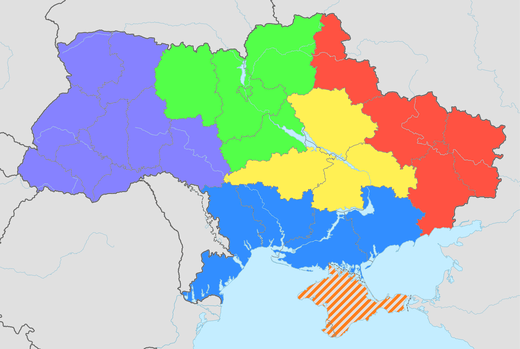
As of 2017 the National Guard is divided in five Operational-Territorial Commands:
- Western Operational-Territorial Command
- Northern Operational-Territorial Command
- Central Operational-Territorial Command
- Eastern Operational-Territorial Command
- Southern Operational-Territorial Command
A sixth Operational-Territorial Command for Crimea has been organized only on paper until the peninsula is returned by Russia to Ukraine (currently the Crimean units are under the National Guard of Russia).
There are various types of units in the National Guard:
- Operational units are military trained and equipped combat forces.
- Public Security Protection and Patrol units fulfil police functions
- Transport units guard troop and prisoner convoys
- Important State Facilities Protection units guard Ukrainian state enterprises involved in missile industry, and Ukraine's nuclear industry
- Independent National Guard units contain a mix of operational, patrol and transport units
In case that martial law would be declared all National Guard units, with the exception of transport units, would come under the command of the Ministry of Defense of Ukraine as auxiliary to the Armed Forces proper.
Directly Subordinated Units
- General Directorate of the National Guard of Ukraine, Kyiv
- National Guard Headquarters Protection & Support Battalion, Kyiv
- NGU Joint Communication Center, Novi Petrivtsi
- Military Band Service of the National Guard of Ukraine
- Headquarters Band of the General Directorate of the National Guard
- 4th Operational Brigade, Hostomel
- Brigade HQ
- 1st Operational Battalion
- 2nd Operational Battalion
- 3rd Operational Battalion
- Tank Battalion
- Artillery Battalion
- Anti-aircraft Missile Battalion
- Support Units
- 22nd Diplomatic Missions & Consular Posts of Foreign States Protection Brigade, Kyiv
- National Guard Air Base/Air National Guard of Ukraine, Oleksandriia
- Headquarters & Headquarters Company
- Air Squadron, Zhuliany Airport (An-74)
- Helicopter Squadron, Oleksandriia Airfield (Mi-8T, MSB-2)
- Technical & Operational Battalion
- Airfield Battalion
- 1st Important State Facilities Protection Regiment, Dnipro, guarding Yuzhmash and Dnipro Machine-Building Plant
- Regiment HQ
- 1st Infantry Battalion
- 2nd Infantry Battalion
- 3rd Infantry Battalion
- Unmanned ground vehicle Detachment
- CBRN-defense Detachment
- 2nd Important State Facilities Protection Regiment, Shostka, guarding Shostka State Plant "Impulse" and Shostka State Plant "Zirka"
- Regiment HQ
- 1st Infantry Battalion
- 2nd Infantry Battalion
- 3rd Infantry Battalion
- Unmanned ground vehicle Detachment
- CBRN-defense Detachment
- 4th Protection of Important State Facilities Protection Regiment, Pavlohrad, guarding Pavlohrad Chemical Plant, Pavlohrad Mechanical Plant and Kharkiv Institute of Physics and Technology
- Regiment HQ
- 1st Infantry Battalion
- 2nd Infantry Battalion
- 3rd Infantry Battalion
- Unmanned ground vehicle Detachment
- CBRN-defense Detachment
- 1st Important State Facilities Protection Battalion, Slavutych, guarding the Chernobyl Nuclear Power Plant
- 2nd Important State Facilities Protection Battalion, Enerhodar, guarding the Zaporizhia Nuclear Power Plant
- 3rd Important State Facilities Protection Battalion, Netishyn, guarding the Khmelnitskiy Nuclear Power Plant
- 4th Important State Facilities Protection Battalion, Yuzhnoukrainsk, guarding the South Ukraine Nuclear Power Plant
- 5th Important State Facilities Protection Battalion, Varash, guarding the Rivne Nuclear Power Plant
- Special Forces Detachment "Scorpion", Kyiv, guarding Ukraine's nuclear industry
- Special Forces Anti-terrorism Detachment "Omega", Novi Petrivtsi
- Central Logistic Base
- Central Weapons & Ammunition Storage Base, Klimentovo
- Central Fuel & Lubricants Supply Base, Zaporizhia
- Military Hospital, Zolochiv
- National Guard Military Academy of Ukraine, Kharkiv
- National Guard of Ukraine Training Center, Zolochiv
Western Operational-Territorial Command
The Western Operational-Territorial Command, headquartered in Lviv, covers the oblasts of Lviv, Chernivtsi, Ivano-Frankivsk, Khmelnytskyi, Rivne, Ternopil, Vinnytsia, Volyn and Zakarpattia.
- Western Operational-Territorial Command, Lviv
- 2nd Independent National Guard Brigade "Halychyna", Lviv
- 8th Operational Regiment "Jaguar", Kalynivka
- 1st Operational Battalion
- 2nd Operational Battalion
- 3rd Operational Battalion
- 40th National Guard Regiment, Vinnytsia
- 45th Operational Regiment, Lviv
- 1st Operational Battalion
- 2nd Operational Battalion
- 3rd Operational Battalion
- 50th National Guard Regiment, Ivano-Frankivsk
- 3rd Patrol Company, Kalush
- 4th Operational Battalion "Kruk", Ivano-Frankivsk
- 5th Infantry Company, Chernivtsi
- Mountain Patrol Company
- 13th Independent National Guard Battalion, Khmelnitsky
- 32nd Separate National Guard Battalion, Lutsk
- Medical Company (Reserve)
- Special Forces Detachment "Vega", Lviv
- Unmanned aerial vehicle Group
- Training Center, Staryi Lysets
- Training Battalion
Northern Operational-Territorial Command
The Northern Operational-Territorial Command, headquartered in Kyiv, covers the city of Kyiv and the oblasts of Kyiv, Cherkasy, Chernihiv and Zhytomyr.
- Northern Operational-Territorial Command, Kyiv
- 1st Operational Brigade, Vyshhorod
- Brigade HQ
- 1st Operational Battalion
- 2nd Operational Battalion
- 3rd Operational Battalion
- Tank Battalion
- Artillery Battalion
- Anti-aircraft Missile Battalion
- Support Units
- 25th Public Security Protection Brigade, Kyiv
- Brigade HQ
- NGU National Honor Guard Battalion, Kyiv
- 1st Patrol Battalion, Kyiv
- 2nd Patrol Battalion, Kyiv
- 3rd Patrol Battalion, Kyiv
- 4th Patrol Battalion, Kyiv
- 5th Patrol Battalion, Kyiv
- 27th (Transport) Brigade, Kyiv
- 1st Operational Battalion "Kulchytskiy", Kyiv
- 1st (Transport) Battalion, Kyiv
- 2nd (Transport) Battalion, Kyiv
- 3rd (Transport) Battalion, Chernihiv
- 25th Separate National Guard Battalion, Cherkassy
- 75th Separate National Guard Battalion, Zhytomyr
- Medical Company (Reserve)
- Unmanned aerial vehicle Group
- Training Center, Starye
- Training Battalion
- 1st Operational Brigade, Vyshhorod
Central Operational-Territorial Command
The Central Operational-Territorial Command, headquartered in Dnipro, covers the oblasts of Dnipropetrovsk, Kirovohrad and Poltava.
- Central Operational-Territorial Command, Dnipro
- 21st Public Order Protection Brigade, Kryvyi Rih
- 1st Patrol Battalion, Kropyvnytskyi
- 2nd Patrol Battalion, Kryvyi Rih
- 16th Public Order Protection Regiment, Dnipro
- 1st Patrol Battalion
- 2nd Patrol Battalion
- 3rd Patrol Battalion
- 12th Separate National Guard Battalion, Poltava
- 14th (Transport) Battalion, Dnipro
- 26th Independent National Guard Battalion, Kremenchug
- Medical Company (Reserve)
- Unmanned aerial vehicle Group
- 21st Public Order Protection Brigade, Kryvyi Rih
Eastern Operational-Territorial Command
The Eastern Operational-Territorial Command, headquartered in Kharkiv, covers the oblasts of Kharkiv, Donetsk, Luhansk and Sumy, and is the frontline command of National Guard forces forward deployed in the ongoing War in Donbass.
- Eastern Operational-Territorial Command, Kharkiv
- 3rd Operational Brigade, Kharkiv
- Brigade HQ
- 1st Operational Battalion
- 2nd Operational Battalion
- 3rd Operational Battalion
- Tank Battalion
- Artillery Battalion
- Anti-aircraft Missile Battalion
- Support Units
- 5th Independent National Guard Brigade "Slobozhansky", Kharkiv
- Brigade HQ
- 1st Infantry Battalion
- 2nd Infantry Battalion
- 3rd Infantry Battalion
- 4th Infantry Battalion
- Support Units
- 15th Independent National Guard Regiment, Sloviansk
- 1st Infantry Battalion
- 18th Operational Regiment (Reinforced), Mariupol
- Regimental HQ
- 1st Patrol Battalion
- 2nd Special Purpose Battalion "Donbas", Mariupol
- Special Purpose Reinforced Battalion "Azov", Mariupol
- Special Patrol Company, Mariupol
- Support Company
- 11th Independent National Guard Battalion, Sumy
- Medical Company (Reserve)
- Special Forces Intelligence Detachment "Ares", Kharkiv
- Unmanned aerial vehicle Group
- Training Center, Malinivka
- Training Battalion
- 3rd Operational Brigade, Kharkiv
Southern Operational-Territorial Command
The Southern Operational-Territorial Command, headquartered in Odessa, covers the oblasts of Odessa, Kherson, Mykolaiv and Zaporizhia.
- Southern Operational-Territorial Command, Odessa
- 23rd Public Order Protection Brigade, Zaporizhia
- 9th Operational Regiment "Gepard", Zaporizhia
- 1st Operational Battalion
- 2nd Operational Battalion
- 3rd Operational Battalion
- 19th Public Order Protection Regiment, Mykolaiv
- 1st Patrol Battalion
- 2nd Patrol Battalion
- 3rd Patrol Battalion
- 49th Public Order Protection Regiment, Odessa
- 16th Independent National Guard Battalion, Kherson
- 19th (Transport) Battalion, Zaporizhzhia
- 34th (Transport) Battalion, Odessa
- Medical Company (Reserve)
- Special Forces Detachment "Odessa", Odessa
- Unmanned aerial vehicle Group
Historic Structure
At the end of 1992, six divisions were formed:
- 1st (Kiev) Division - Kyiv, Zhytomyr
- 2nd (East) Division - Kharkiv, Chuhuiv, Luhansk
- 3rd (South) Division - Odesa, Kharkiv, Simferopol, Sevastopol, Mykolaiv, Kherson
- 4th (North) Division - Donetsk, Dnipro, Mariupol, Pavlohrad, Kryvyi Rih
- 5th (West) Division - Lviv, Lutsk, Ivano-Frankivsk, Ternopil, Drohobych
- 6th Division - Chuhuiv (formed from the 48th Motor Rifle Division and became the 92nd Mechanized Brigade in 1999)
- 7th (Crimean) Division - Simferopol (from 1996 - formed from 126th Motor Rifle Division)
Other elements included, at various times:
- Academy of the Internal Troops[lower-alpha 2]
- School for senior NCO (Kharkiv)
- Training Brigade - Zolochiv, Lviv region[21]
- Training Regiment - Donetsk
- Novorossiysk-Kyiv Separate Guards Regiment (Presidential Guard unit[16])[22][lower-alpha 3]
- 22nd Separate Guards brigade for the protection of foreign embassies - Kiev
- Logistics Regiment - Kiev.
- Aviation Management NSU[lower-alpha 4]
- Separate Tank Battalion 1st Division NSU (PT-76) [lower-alpha 5]
- 1st Tank Battalion [independent tank battalion (T-64B)][lower-alpha 6]
- Separate reconnaissance Airborne company, assigned to the 6th Division NSU[lower-alpha 7]
- Special battalion "Lavender" - Mountain Troops reconnaissance battalion[lower-alpha 8]
Under the pre-2000 structure,[lower-alpha 9][lower-alpha 10] the National Guard administratively came under the Ministry of Internal Affairs but operationally answered directly to the President of Ukraine, though prior to 1995 parliament had some operational oversight. In the 2014 structure, it reports both administratively and operationally to the Minister of Internal Affairs, a position at present held by Arsen Avakov. In the old NSU, its overall Commander was originally appointed by the Presidium of the Verkhovna Rada (Ukrainian Parliament) for 5-year terms. His Deputy Commander was appointed to the post by the President of Ukraine upon a submission from the Commander. However, in 1995 the system was changed so that both the Commander and Deputy Commander would be appointed by the President.
.jpg)
Also part of the NSU was the Military Council, which approved the personal staff of the President of Ukraine based on submissions from the Commander, and the Department of National Guard, an administrative entity acting in accordance with the terms of reference approved by the President of Ukraine. This included the Guard's secondary Disaster management role.[lower-alpha 11]
2014 Organisation and Structure
As of late March 2014, it was still in flux. However, current developments suggest that the 'new' National Guard will primarily be a Light infantry force, heavily reliant on reserve units with a few mechanized and armor support elements. This is in contrast to the 'old' National Guard, which was mostly a Mechanized infantry force, albeit one that incorporated a number of specialized formations and units, along with organic armor, artillery and air support elements.
The first of the new National Guard's regular battalions formally paraded on 6 April,[23] after only three weeks of training. The unidentified battalion consists of 500 members of between 18 and 55 years of age, and it appears to be tasked as a rapid reaction force, using soft skinned vehicles such as trucks for transport.
The 4th Rapid Reaction Brigade was formed as part of the National Guard on 2 June 2015.[24]
The commander of the National Guard of Ukraine is appointed by the president since 25 December 2015.[25] Up until then, the commander was appointed by the Verkhovna Rada (Ukraine's parliament) under a motion from the President.[1]
Azov Battalion
Named after the Sea of Azov the unit was created in Mariupol which is a major coastal city and operates as the capital of Donetsk Oblast due to the occupations of Donetsk by insurgents. The unit was one of the first battalions to form and begin to resist the rebels playing a large role in the defence of Mariupol.[26] The battalion is mostly composed of Russian speaking volunteers from Eastern Ukraine and is headed by Andriy Biletsky.
The unit is known for far right agenda and has been reported as displaying Nazi symbols. The unit denies the allegation that they use Nazi symbols claiming that their logo is based on the Coat of Arms of Ukraine[27] while elements of the national flag are also used.
It was upgraded into a full regiment in 2015, and is the only one with foreign soldiers in their ranks. It is also the NG's only territorial defence regiment in service.
Donbas Battalion
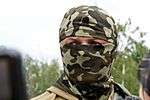
The most well known and first volunteer battalion to form to resist Russian insurgents in the Donbass, often referred to as the "little black men" as an analog to Crimea's Little green men. The unit was conceived and is headed by Semen Semenchenko, an ethnic Russian. It formed from local ethnic Russian volunteers of the Donbass region who disagreed with the separatist philosophy and wished to remain part of Ukraine but were dissatisfied with the inaction of Ukrainian government forces in the area. In effect it is an analog of the separatist formed Vostok Battalion which formed from ethnic Russians fighting for separatism.
Since its formation the unit became much more diverse accepting volunteers from all over Ukraine and foreign nations into their ranks, however ethnic Russians still make up the majority of the unit. The unit is one of the largest volunteer battalions in Ukraine with nearly 1,000 members and has participated in most major battles since the start of the War in Donbass.[28] Despite being part of the Ministry of Internal Affairs’ National Guard unit, battalion had received funding from various donors.[29] The unit also aided in the defence of Mariupol when Russian forces invaded through Novoazovsk, the battalion sent several tank destroyers to slow the Russian advance. The offensive toward Mariupol was halted near Shyrokyne and Bezimenne.[30]
In September 2014 the unit was reorganized into a Regiment the bulk of which consisted of a 700-man Battalion Tactical Group. The Ministry of Defence stated that the unit would be armed with tanks and armored personnel carriers. A Spetsnaz unit within the battalion was also formed.[31] The unit has been re-designated as the 3rd Reserve Battalion of the National Guard of Ukraine after being integrated into regular forces, but the Spetsnaz company remained.
Commanders
- 1991–1995 Lieutenant General Volodymyr Kukharets[32]
- 1995–1996 Lieutenant General Oleksandr Kuzmuk[33]
- 1996–1998 Lieutenant General Ihor Valkiv[34]
- 1998–2000 Lieutenant General Oleksandr Chapovsky[35]
- 2000–2014 transferred to the Internal Troops
- 2014 Lieutenant General Stepan Poltorak
- 2014–2015 Lieutenant General Mykola Balan
- 2015-2019 Colonel General Yurii Allerov
- From 7 May 2019 Lieutenant General Mykola Balan
Training
New recruits (those not transferring in from the Internal Troops, Ground Forces or military academies) will undergo an initial two-week compressed training course, covering a range of areas from firearms and unarmed combat, to map reading and communications. Those signing up to be full-time members of the Guard will receive at least an additional four weeks of training.[lower-alpha 12] For those part-time members who complete their two-week training and return to their communities to await call-up, the authorities appear to be planning to implement a variation of the March battalion system; based where possible around existing civilian militias and armed groupings. Most of those use the sotnya as their basic unit, as does the National Guard itself.
In March 2015, the National Guard of Ukraine received training from the U.S. 173rd Airborne Brigade Combat Team. The training took place at the Yavoriv training center near the western Ukrainian city of Lviv. The 173rd Airborne paratroopers trained the Ukrainians on how to better defend themselves against "Russian and rebel artillery and rockets." Training also included securing roads, bridges, and other infrastructure and treating and evacuating casualties.[36]
Officers and NCOs of the NGU are trained under the aegis of the National Guard Military Academy of Ukraine.
Ranks and insignia
Officers
| Equivalent NATO Code | OF-10 | OF-9 | OF-8 | OF-7 | OF-6 | OF-5 | OF-4 | OF-3 | OF-2 | OF-1 | OF(D) & Student officer | |||||||||||||||||||||||||
|---|---|---|---|---|---|---|---|---|---|---|---|---|---|---|---|---|---|---|---|---|---|---|---|---|---|---|---|---|---|---|---|---|---|---|---|---|
(Edit) |
 |
 |
 |
 |
 |
 |
 |
 |
 |
 |
 |
 |
 | |||||||||||||||||||||||
| General of the Army of Ukraine (Генерал армії України) |
Colonel general (Генерал-полковник) |
Lieutenant general (Генерал-лейтенант) |
Major general (Генерал-майор) |
Brigadier general (Бригадний генерал) |
Colonel (Полковник) |
Lieutenant colonel (Підполковник) |
Major (Майор) |
Captain (Капітан) |
Senior lieutenant (Старший лейтенант) |
Lieutenant (Лейтенант) |
Junior lieutenant (Хорунжий) |
Officer cadet (курсант) | ||||||||||||||||||||||||
Other Ranks and NCOs
| Equivalent NATO code | OR-9 | OR-8 | OR-7 | OR-6 | OR-5 | OR-4 | OR-3 | OR-2 | OR-1 | |||||||||||||||||||||||||||
|---|---|---|---|---|---|---|---|---|---|---|---|---|---|---|---|---|---|---|---|---|---|---|---|---|---|---|---|---|---|---|---|---|---|---|---|---|
(Edit) |
 |
 |
 |
 |
 |
 |
 |
 |
 |
 | ||||||||||||||||||||||||||
| Chief Master Sergeant Головний майстер-сержант |
Senior Master Sergeant Старший майстер-сержант |
Master Sergeant Майстер-сержант |
Staff Sergeant Штаб-сержант |
Chief Sergeant Головний сержант |
Senior Sergeant Старший сержант |
Sergeant Сержант |
Junior sergeant Молодший сержант |
Senior Soldier (Private 1st Class) Старший солдат |
Soldier (Private) Солдат | |||||||||||||||||||||||||||
Equipment
See also
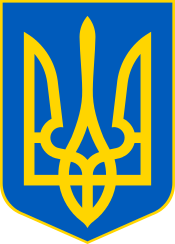 |
|---|
| This article is part of a series on the politics and government of Ukraine |
|
Presidency
|
|
Executive |
|
|
|
- Novi Petrivtsi - Location of one of the training bases for the National Guard
- Aid to the Civil Power
- Battalions of territorial defense in Ukraine
Notes
- "Actions aimed at the violent overthrow, change of constitutional order, or the seizure of state power"
- The Institute and Senior NCO school were both created out of the Soviet era Kharkov Higher Military School of Logistics Ministry of Internal Affairs of the USSR
- The Novorossiysk-Kyiv separate regiment was moved to the Ukrainian Ground Forces upon disbandment of the original National Guard.[16]
- Consisted of an administrative element and two primary units; the 51st Separate Helicopter Brigade and the 31st Separate Combat Helicopter Squadron. The former had 29 transport helicopters on strength at its formation, including Mil Mi-6s, Mi-26s, and Mi-8MTs. The latter had an initial TOE of 12 Mi-24 attack helicopters and 6 Mi-8MT transport helicopters.
- Active as such between 1992 and 1993. Afterwards gave its tanks up to the Ground Forces and became the training battalion for the 1st Division.
- Formed from the remnants of the 93rd Motorized Rifle Division. The tank battalion of a typical Soviet style Motor Rifle Regiment consisted of three companies, each in turn containing three platoons with four tanks apiece. Each Motor Rifle Division primarily consisted of three Motor Rifle Regiments and a Tank Regiment, the latter in turn containing three tank battalions each having a strength of 31 tanks (plus support elements including a ZSU AA battery). It is somewhat uncertain if the independent battalion was at its theoretical maximum full complement of 36 tanks upon its formation, however.
- In other words an Airborne Spetsnaz unit. Its primary role was special reconnaissance, though it also carried out other ISR taskings, as well as Special Operations and Counter-Terrorism operations during its lifetime, with corresponding name changes. May have had a few BTR-Ds on strength, but this is by no means certain.
- Likely closer to reinforced company strength in actuality.
- The Skorpion (Scorpion) unit, also known as the 'crimson berets', was originally the special forces battalion of the pre-2000 National Guard.[16] It is unknown at this time (late March 2014) whether it will rejoin the revived National Guard.
- The Kobra (Cobra) mountain-rifle battalion may have originally been the Guard's Alpine warfare unit, but sources are not clear on this point.
- According to the legislation that revived the National Guard, the 'new' Guard is supposed to have a similar role but there is no solid information on that aspect of its operations and responsibilities as of late March 2014.
- However, at least one regular battalion has been stood up with only three weeks total of training.[Early April 2014]
References
- Turchynov proposes parliament appoint Poltorak as National Guard commander, Interfax-Ukraine (19 March 2014)
- Avakov announces large-scale "cleansing" among generals UNIAN (17 August 2016)
- "Ukraine: National Guard Restored". Library of Congress. 4 April 2014. Retrieved 15 June 2020.
- Yaroslav Mezentsev (10 May 2011). Холодна війна за Крим. Як ділили флот у 1990-х [Cold war over Crimea. How the fleet was divided in 1990.] (in Ukrainian). istpravda.com.ua.
- "President declares March 26 Day of National Guard". Interfax-Ukraine. 18 March 2015.
- Рада создала Национальную гвардию Украины [Parliament has established the National Guard of Ukraine]. rbc.ua (in Russian). 13 March 2014.
- "Ultra-nationalist Ukrainian battalion gears up for more fighting". Reuters. Retrieved 15 June 2015.
- "Volunteers Bolster Ukraine's Fighting Force". Institute for War and Peace Reporting. Retrieved 15 June 2015.
- Ukraine underplays role of far right in conflict, BBC News (13 December 2014)
- "The women fighting on the frontline in Ukraine". The Guardian. Retrieved 15 June 2015.
- Проект Закону про Національну гвардію України [Draft Law of Ukraine on the National Guard; Act 876-VII] (in Ukrainian). Verkhovna Rada. 13 March 2014.
- В Украине объявили о создании Национальной гвардии: Начинается мобилизация опытных военных [The establishment of the National Guard of Ukraine is announced: Mobilization of expert military begins]. www.NR2.ru (in Russian). 11 March 2014. Archived from the original on 11 March 2014.
- Roman Goncharenko (20 March 2014). "Can the National Guard save Ukraine?". Deutsche Welle.
- "Ukraine creates National Guard ahead of Crimea vote". BBC.com. 13 March 2014.
- Chris Morris (16 March 2014). "Kiev expects West response after Crimea vote". BBC.com.
- "Ukrainian National Guard". GlobalSecurity.org. Retrieved 24 March 2014.
- Anthony Faiola (17 March 2014). "Ukraine mobilizes reservists but relies on diplomacy". Washington Post. Retrieved 24 March 2014.
- "Death Toll Rises To Three From Grenade Attack Near Ukrainian Parliament". rferl.org. Retrieved 4 October 2018.
- "Avakov speaks of losses of National Guard". UNIAN. 18 April 2016. Retrieved 18 April 2016.
- Військова частина 2260 (м. Київ) [Military unit 2260 (Kyiv)] (in Ukrainian). vv.gov.ua. Archived from the original on 26 August 2014. Retrieved 1 May 2014.
- Training center. NGU website. accessed 1 May 2014.
- Martial way Novorossiysk 290 Red Regiment. 290 Regiment formed in April 1942 as part of mechanized infantry units of internal troops. During World War II the regiment had been about the protection and defense of the Georgian Military Road, took part in the assault and liberation of the city of Novorossiysk, for which he was awarded the honorary title of "Novorossiysk". The regiment performed garrison service tasks and elimination of hostile elements in areas liberated from Nazi occupation. In 1945, the work provided the Yalta Conference of State anti-Hitler coalition. On 24 November 1945, the regiment was relocated to the city of Kiev, where the personnel performing the functions inherent internal forces (combat gang violence, criminal groups, public order and public authorities in Kiev). 1945–1947 years - units of the regiment took part in the fight against gang violence in western Ukraine. In 1970, the regiment provided the public order in Odesa for eliminating the cholera epidemic. In 1980 he took part in ensuring public order during the Olympic Games. In 198 5 he ensured public order at Moscow during the World Youth Forum. From 26 April 1986 till May 1987 took part in the aftermath of the Chernobyl accident (protection of public order, combating looting). From 1988 to 1991 served as a peacekeeping mission in the Caucasus. In 1992 the regiment joined the National Guard of Ukraine. Only part of the National Guard of Ukraine carried out the functions and tasks that are at present assigned to the Internal Troops of Ukraine. After the disbanding of the National Guard of Ukraine in 2000 according to the Decree of the President of Ukraine, he was transferred to the Armed Forces of Ukraine and at its base the 1 single Novorossiysk-Kiev Order of the Red Banner Regiment of the President of Ukraine (in / hr A-0222). Source http://voiska.ru/forum/index.php?showtopic=250
- Перший батальйон Національної гвардії склав присягу [First battalion of the National Guard sworn in]. Unian Agency (in Ukrainian). 6 April 2014.
- "Arsen Avakov: "The NGU light infantry brigade represents a new model of military unit" (PHOTOS, VIDEO)". Ministry of Internal Affairs of Ukraine. Archived from the original on 21 September 2016. Retrieved 1 July 2016.
- "Verkhovna Rada transferred the authority to name the commander of the National Guard to the president". Ukrayinska Pravda (in Ukrainian). 25 December 2015. Retrieved 25 December 2015.
- "Ukrainian troops drive rebels out of Mariupol". USA Today. 13 June 2014.
- "Russians Join Ukraine's Azov Battalion: Volunteers say Putin regime poses threat to Europe". Ukraine Today.
"Ukraine underplays role of far right in conflict". BBC. 13 December 2014. - Shynkarenko, Oleg (26 June 2014). "Volunteers Bolster Ukraine's Fighting Force". Institute for War and Peace Reporting.
- Ayres, Sabra (29 June 2014). "The Donbass Battalion prepares to save Ukraine from separatists". Aljazeera America. Retrieved 23 March 2016.
- "Donbas battalion sends groups of tank destroyers to stop armored vehicles that crossed into Ukraine near Novoazovsk". Kyiv Post. 25 August 2014. Archived from the original on 25 August 2014.
- "Батальон "Донбасс" преобразован в батальонно-тактическую группу". Liga.
- NGU Commander Guard Lt.General V. Kukharets. Spetsnaz NGU. 24 March 2013
- NGU Commander Guard Lt.General O.Kuzmuk. Spetsnaz NGU. 24 March 2013
- NGU Commander Guard Lt.Guard I.Valkov. Spetsnaz NGU. 24 March 2013
- NGU Commander Guard Lt.General O.Chapovsky. Spetsnaz NGU. 24 March 2013
- Fox News
External links and further reading
| Wikimedia Commons has media related to National Guard of Ukraine. |
- Official website
- National Guard recruitment webpage, operated by the Ministry of Internal Affairs (In Ukrainian). Accessed 29 March 2014.
- Spetsnaz NGU. Unofficial website.
- Taras Kuzio, "The non‐military security forces of Ukraine." The Journal of Slavic Military Studies 13, no. 4 (2000): 29-56.
